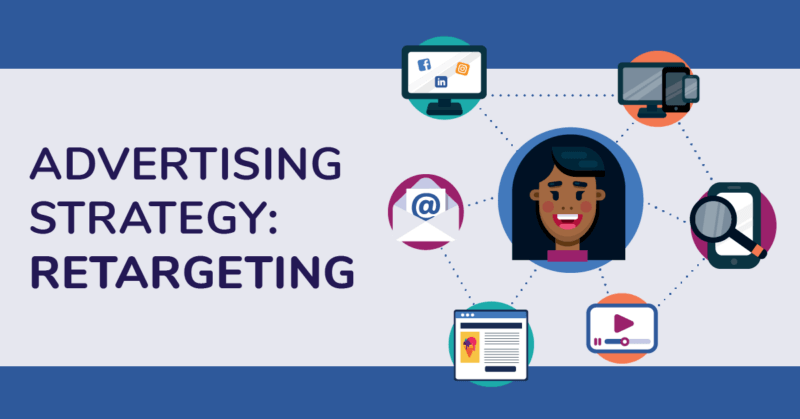How retargeting ads work

In our crash course on full-funnel marketing, we discussed the importance of using a full-funnel strategy to nurture customers through the marketing funnel. Although it’s important to fill your funnel with new users, what about those middle-of-the-funnel customers who leave before converting? How do businesses like yours inspire users who visited your website, landing page, or social media profile to return and act? One way to do this is through retargeting ads.
At MPP, we want you to reach the right people, at the right place, at the right time. For many customers, a retargeting ad may be the key to converting. Retargeting might seem complicated, but once you know the basics, you’ll understand why it can be a crucial part of a full-funnel marketing strategy. Let’s learn what retargeting is, how it works, and how you can use retargeting to help your ad budget work smarter.
What is retargeting?
Retargeting ads are shown to people who already visited you online but didn’t make a purchase or take a desired action. Retargeting ads are often successful at converting visitors because you are front and center as users are scrolling on social media, browsing their favorite websites, or researching your competitors.
Take this retargeting ad example: Jenny is looking for the perfect gift for her mom. As she’s scrolling through Instagram, she clicks on an ad for a local candle company. She adds a candle to her cart but leaves the site before making a purchase.
A few days later, Jenny is reading a recipe on her favorite food blog and notices an ad for the candle company across the top of the page. This reminds her to order a candle for her mom.
Although Jenny didn’t fill out a contact form or make a purchase when she first visited the candle website, retargeting ads reminded her about the brand, which prompted her to make a purchase.
How do retargeting ads work?
Retargeting ads audiences were traditionally created using tracking cookies. Every time someone visited your site, an invisible pixel placed a cookie into their browser and began tracking the pages and products the user viewed while browsing. With this data gathered through cookies, marketers used third-party providers such as the Google Display Network to show retargeting ads to those users in hopes they would return to your site.
Although third-party cookies were the backbone of retargeting strategies for years, they are becoming a relic of the past. With privacy concerns on the rise, many platforms are eliminating or have already eliminated third-party cookies and are shifting to a first-party data approach. In fact, Google is totally removing cookies in Chrome by 2024.
Although this is a huge change, retargeting ads aren’t leaving us – they are adapting. On Google Display Network, retargeting ads will use first-party data to create user groups that share similar characteristics. Ads will be served to users that fall into these groups.
Now is the best time for businesses and marketers to be proactive and focus on first-party data marketing to build these user groups. We dive deeper into the deprecation of third-party cookies and ways you can succeed in a cookie-less world in this article.
Types of retargeting ads
You can reach customers in all sorts of ways with retargeting ads, through web searches or website visits, social media, and more. All methods can be effective at bringing traffic back to your website and increasing sales or leads. Let’s break down each of these retargeting types in detail.

Site retargeting
Our earlier scenario with Jenny is an example of site retargeting. This is for users who visited your website but didn’t convert. Advertising partners will serve display retargeting ads on platforms such as Google Ads, Bing, LinkedIn, and Facebook on both mobile and desktop devices.

Social media retargeting
Social media retargeting is like site retargeting, but ads are strictly shown on social media platforms. Users on social media tend to be more engaged while they’re browsing, so make the most of retargeting ads by customizing them for specific audiences.
- Sharing their email with you
- Following your Facebook Page or interacting with it
- Interacting with a Facebook Event
- Watching a certain amount of your on-platform videos (ad videos included)
- Interacting with your app
- Viewing certain pages of your site
- Taking certain actions on your website
- Interacting with your Instagram Page

Search retargeting
Search retargeting is based on the user’s search behavior. In short, this means your display ads are shown to people who have searched for certain keywords. These ads can show up on search engine results pages (SERPs) and social media sites.
Benefits of retargeting ads
As with any marketing strategy, there are pros and cons when it comes to adding retargeting ads to your mix. Retargeting is great for:
Brands or businesses that have a website
Retargeting strategy only works if you have a website. Sites will need to have clear structure and navigation and see a decent amount of web traffic. We always recommend sending audiences to specific landing pages to grow conversions. If nobody is coming to your site or if there is no straightforward way for visitors to act (such as making a purchase or filling out forms), it will be difficult to see results.
Building brand awareness
Very few visitors will convert when they are introduced to a brand for the first time. Keeping your brand in front of them will help build awareness. The aim of retargeting is to earn your potential customers’ trust by making them comfortable with you.
More conversions
Statistics show that users that visit a website after clicking on a retargeting campaign ad are more likely to convert by up to 70% compared to those that aren’t retargeted. That’s a huge fraction of your audience! The key to conversions is personalization. Retargeting ads result in better conversion rates because you are targeting the right people with relevant ads.
As with all aspects of digital marketing, retargeting requires commitment. Don’t expect to see instant results. It may take a few months to notice the impact of your campaigns — and you’ll probably have to test and tweak your messaging along the way.
Retargeting ads turn window shoppers into customers
Retargeting ads remain a powerful tool to use to get in front of those middle-of-the-funnel audiences. Adapting to the changing retargeting landscape is crucial for long-term success. Focus on ethical data practices (first-party data), leverage new technologies, and create personalized experiences to engage your audience. Finding the right creative with the right messaging can be the difference between a casual browser and a customer.


